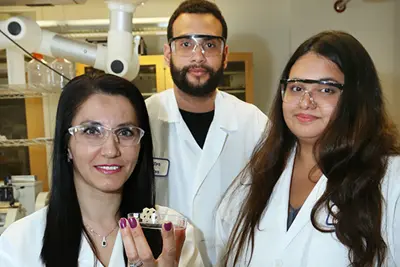Study Is Funded by $300K Grant from the American Heart Association
 Image by Edwin L. Aguirre
Image by Edwin L. Aguirre
Asst. Prof. Gulden Camci-Unal, right, and Ph.D. student Sanika Suvarnapathaki use a Zeiss Axio fluorescence microscope to take images of heart cells that are grown in the biomaterials they are developing at the Saab Emerging Technologies and Innovation Center on North Campus.
10/10/2019
By Edwin L. Aguirre
A research team led by Asst. Prof. Gulden Camci-Unal of the Department of Chemical Engineering is developing new “breathable” biomaterials that can repair heart muscle damaged by disease or heart attack. The work is supported by a three-year grant worth nearly $300,000 from the American Heart Association.
Camci-Unal and her team are synthesizing biodegradable polymeric materials to serve as stable 3D scaffolds for growing new blood vessels in heart tissue implants.
According to Camci-Unal, biomaterials with high oxygen content represent a major step toward creating functional tissues with well-connected blood supplies that can restore damaged heart tissue.
“Our new biomaterial can provide oxygen on demand up to several weeks to enhance cell survival and function. The material is also biocompatible with cardiac cells, which means it will not trigger a reaction from the body’s immune system,” she says. “The technology can be applied not only to repairing damage due to cardiovascular disease, but also to heart degeneration, aging or trauma.”
Current biomaterials that provide oxygen are limited by their inability to administer enough oxygen in a controlled and sustained fashion into thick tissues such as the heart muscle, Camci-Unal notes.
“Our goal is to develop biomaterials that can provide oxygen on demand, similar to breathing. Our unique polymeric material will be able to supply the cardiac muscle cells, called cardiomyocytes, with oxygen slowly when they need it, and we will be able to fine-tune the biomaterial’s properties,” she says.
A Growing Health Crisis
 Image by Gulden Camci-Unal
Image by Gulden Camci-Unal
This highly magnified view taken with a scanning electron microscope shows the structure of the biomaterial from Camci-Unal’s lab.
About half of the country’s population, or 121.5 million in 2016, suffers from some form of cardiovascular disease, the report states. And the direct and indirect costs of treating heart disease, stroke and cardiovascular disease in America are estimated to total more than $350 billion. This includes health care services, medications and lost productivity.
A common cardiovascular disease is ischemic heart disease, which occurs when the cardiac tissue is deprived of oxygen. “This could lead to progressive loss of function and death of cardiac cells, formation of scar tissue, thinning of the ventricular wall and progressive heart failure in later stages,” Camci-Unal says.
A major problem associated with today’s biomaterials used in heart repair is that they typically are not only non-biodegradable and not adequately porous, but they also contain insufficient amount of oxygen, which can cause cell damage.
“Some of the available materials supply a burst release rather than providing a controlled supply in the long term. Adequate oxygen must be provided to the cells for an extended period of time to help promote the formation of blood vessels, especially in thick tissue implants,” explains Camci-Unal.
 Image by Edwin L. Aguirre
Image by Edwin L. Aguirre
“We currently have a review paper accepted in the journal Nature Asia Materials on this topic,” says Camci-Unal. “We are also applying for a patent for the technology.”
Using Unconventional Raw Materials for Tissue Engineering
Camci-Unal has been using common raw materials to design new biomaterials for tissue engineering. In 2018, using origami (the Japanese art of paper folding) as inspiration, she and her student researchers used plain paper to create tiny 3D scaffolds where biomaterials can grow, and then applied microfabrication techniques to engineer new tissues. These could someday be used to repair, replace or regenerate skin, bone, cartilage, heart valves, heart muscle and blood vessels.
Earlier this year, she also investigated the use of powdered eggshells for engineering bone tissue that could be applied to treat and repair bones in patients who have suffered injuries due to aging, cancer and other diseases, as well as in accidents or in combat. The technique can also be used to grow cartilage, teeth and tendons.
“These novel biomaterials can offer a solution to the global shortage of donors for tissue and organ transplants,” says Camci-Unal.




